|
|
|
Sort Order |
|
|
|
Items / Page
|
|
|
|
|
|
|
| Srl | Item |
| 1 |
ID:
108123


|
|
|
|
|
| Publication |
2011.
|
| Summary/Abstract |
This article explores the relationship between the UK and Rwanda, using the lens of the UK Department for International Development's integrated approach to state building and peace building in fragile and conflict-affected states. It identifies a number of priorities for UK aid under such a framework, but shows that in the case of Rwanda these have not been foregrounded in the bilateral aid relationship. The article suggests a number of reasons for this, arguing that, by refusing to acknowledge or address Rwanda's deviations from what was considered a positive development trajectory, the UK is becoming internationally isolated in its support for the rpf regime. It concludes that, while this bilateral relationship may support achievement of stability and relative security in Rwanda, promoting such a narrow form of state building is detrimental to more holistic peace building, both nationally and regionally.
|
|
|
|
|
|
|
|
|
|
|
|
|
|
|
|
| 2 |
ID:
130356
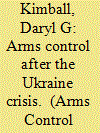

|
|
|
|
|
| Publication |
2014.
|
| Summary/Abstract |
The Global Nuclear Disarmament and risk reduction enterprise is at a crossroads as U.S.-Russian relations have reached perhaps their lowest point in more than a quarter century. Nevertheless, it remains in U.S. and Russian interests to implement existing nuclear risk reduction agreements and pursue practical, low-risk steps to lower tensions. Present circumstances demand new approaches to resolve stubborn challenges to deeper nuclear cuts and the establishment of a new framework to address Euro-Atlantic security issues.
Even before the recent political turmoil in Ukraine and Russian President Vladimir Putin's extralegal occupation and annexation of Crimea, relations between Moscow and Washington were chilly. Despite U.S. adjustments to its missile defense plans in Europe that eliminate any threat to Russian strategic missiles, Putin rebuffed U.S. President Barack Obama's proposal last June to reduce U.S. and Russian strategic stockpiles by one-third below the ceilings set by the New Strategic Arms Reduction Treaty (New START).
Moving forward will be difficult, but doing nothing is not an option. Through earlier crises during and after the Cold War, U.S. and Russian leaders pursued effective arms control and disarmament initiatives that increased mutual security and significantly reduced the nuclear danger. Much has been achieved, albeit too slowly, but there is far more to be done.
As the world's non-nuclear-weapon states persuasively argue, U.S. and Russian stockpiles still far exceed any plausible deterrence requirements, and the use of just a few nuclear weapons by any country would have catastrophic global consequences. As the 2015 Nuclear Nonproliferation Treaty (NPT) Review Conference approaches, pressure to accelerate action on disarmament will only grow.
For now, neither Russia nor the United States wants to scrap the existing arms control regime, including New START and the Intermediate-Range Nuclear Forces (INF) Treaty, which provide greater predictability and stability in an otherwise strained bilateral relationship. A return to a period of unconstrained strategic nuclear competition would not only deepen the distrust and increase dangers for both sides, but also would undermine the NPT. Scrapping the existing nuclear risk reduction measures would do nothing to protect Ukraine from further Russian aggression or reassure nervous NATO allies.
Unfortunately, the profound tensions over Ukraine delay the possibility of any formal, bilateral talks on nuclear arms reductions and missile defense. In light of these realities, Obama and other key leaders must explore alternative options to reduce global nuclear dangers and defuse U.S.-Russian strategic tensions.
|
|
|
|
|
|
|
|
|
|
|
|
|
|
|
|
| 3 |
ID:
122175
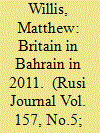

|
|
|
|
|
| Publication |
2012.
|
| Summary/Abstract |
Britain's longstanding and complex relationship with Bahrain was put under intense pressure by the unrest that spread through the Gulf state in February 2011. The kingdom's regional strategic significance, and its enduring dependability, make it a key ally for the UK - yet Britain's values-driven policy also compelled it to encourage negotiation and reform, rather than unconditionally support the Bahraini government's repressive approach. Matthew Willis analyses the bilateral relationship between the two countries, and shows how, so far, Britain has had little success in encouraging the Gulf state to reform.
|
|
|
|
|
|
|
|
|
|
|
|
|
|
|
|
| 4 |
ID:
115091
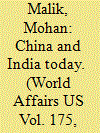

|
|
|
|
|
| Publication |
2012.
|
| Summary/Abstract |
Just as the Indian subcontinental plate has a tendency to constantly rub and push against the Eurasian tectonic plate, causing friction and volatility in the entire Himalayan mountain range, India's bilateral relationship with China is also a subtle, unseen, but ongoing and deeply felt collision, the affects of which have left a convoluted lineage. Tensions between the two powers have come to influence everything from their military and security decisionmaking to their economic and diplomatic maneuvering, with implications for wary neighbors and faraway allies alike. The relationship is complicated by layers of rivalry, mistrust, and occasional cooperation, not to mention actual geographical disputes.
|
|
|
|
|
|
|
|
|
|
|
|
|
|
|
|
| 5 |
ID:
128918
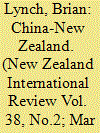

|
|
|
| 6 |
ID:
177300
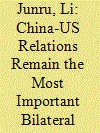

|
|
|
| 7 |
ID:
140278
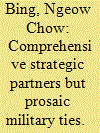

|
|
|
|
|
| Summary/Abstract |
Malaysia and China upgraded their relationship to a Comprehensive Strategic Partnership in 2013 and signed a Joint Communique in 2014. Although the Comprehensive Strategic Partnership includes a pledge to strengthen cooperation between the armed forces of the two countries, so far, however, Sino–Malaysian defence ties have advanced only incrementally. This article focuses on the development of defence relations between the two countries from 1991 until the first half of 2015. It examines several areas of defence diplomacy, including visits by senior officials, the exchange of military students, arms sales, defence and security consultations and combined military exercises. It concludes that although Malaysia–China defence ties have not developed as quickly as other aspects of the bilateral relationship, this does not mean that the Comprehensive Strategic Partnership lacks depth, or that Kuala Lumpur fundamentally distrusts Beijing because of recent developments in the South China Sea.
|
|
|
|
|
|
|
|
|
|
|
|
|
|
|
|
| 8 |
ID:
120166
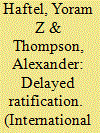

|
|
|
|
|
| Publication |
2013.
|
| Summary/Abstract |
Some treaties are signed and then ratified quickly while others languish in legal limbo, unratified by one or more parties. What explains this variation in the time between signature and ratification? The international relations literature has not taken the ratification stage seriously enough, despite its obvious importance from a legal and a political perspective. We offer a systematic study of this question in the context of bilateral investment treaties. We develop and test a set of theoretical propositions related to domestic-level constraints on the executive, the varying ability of governments to rationally anticipate ratification obstacles, and the bilateral relationship between treaty partners. We generally find support for these propositions but report some surprising findings as well. The article presents implications for investment agreements and treaty making more generally, and raises a number of issues for further study at the intersection of international politics and law.
|
|
|
|
|
|
|
|
|
|
|
|
|
|
|
|
| 9 |
ID:
148098
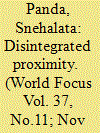

|
|
|
|
|
| Summary/Abstract |
Geography is as much an advantage as it is a problem to cultivate and maintain good relationship with India’s South Asian neighbours. A plethora of territorial,historical ,cultural and ethnic problems have persistently disturbed bilateral relationship. In all these countries there are sections supporting engagement with India and opposing it. Bilateral relationship vacillates between good and worse according to the section that holds the reins of political power though in case of Pakistan influence of the military remains constant.
|
|
|
|
|
|
|
|
|
|
|
|
|
|
|
|
| 10 |
ID:
145780
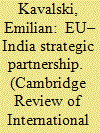

|
|
|
|
|
| Summary/Abstract |
While formally labelled as ‘strategic’, the European Union (EU)–India partnership is more often than not described as ‘lukewarm’ and ‘reluctant’. Thus, by process-tracing the EU–India relationship, this article reveals the significance of 1999 as a crucial point that has urged both Brussels and New Delhi to significantly alter both their outlook on global life and on each other. The bilateral relationship will be shown to be a story of two actors aspiring to global prominence, who—to their mutual frustration—find themselves consigned and constrained to play a leading role only in their respective neighbourhoods. The bilateral relationship seems only to reinforce this marginalization in global affairs, as neither of the strategic partners considers the other significant enough to develop meaningful relations with them.
|
|
|
|
|
|
|
|
|
|
|
|
|
|
|
|
| 11 |
ID:
108665
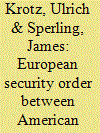

|
|
|
|
|
| Publication |
2011.
|
| Summary/Abstract |
We investigate the impact of historically rooted domestic constructions of purpose and ambition on the patterns of discord and collaboration in the Franco-American relationship over the course of the postwar and post-cold war periods. We stress the importance and tenacity of domestic historical constructions for explaining and understanding the foreign policy strategies that would otherwise confound a power-based analysis. The Franco-American bilateral relationship, in particular, illustrates the persistence and tenacity of each nation's historically constructed foreign policy conception during the bipolar distribution of power during the cold war and the contested unipolarity of the post-cold war era. We conclude with an assessment of the salience and relevance of domestic elements of foreign policy role and purpose for explaining and understanding how their bilateral relationship has affected the European security order into the second decade of the twenty-first century.
|
|
|
|
|
|
|
|
|
|
|
|
|
|
|
|
| 12 |
ID:
146473


|
|
|
| 13 |
ID:
129129


|
|
|
| 14 |
ID:
129153
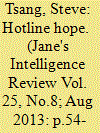

|
|
|
| 15 |
ID:
159942
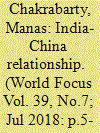

|
|
|
|
|
| Summary/Abstract |
Bilateral Relationship between India and China When we speak of bilateral relationship between two countries, it should be kept in mind that every nation’s problems and prospects are significantly determined by history, heritage and its location on the globe. (Rowland,1967.) There is no denying the fact that bilateral relationship between two neighbouring countries are of great significance.
|
|
|
|
|
|
|
|
|
|
|
|
|
|
|
|
| 16 |
ID:
118534
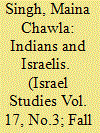

|
|
|
|
|
| Publication |
2012.
|
| Summary/Abstract |
India and Israel established full diplomatic relations in 1992. Bilateral trade has grown from $200m in 1992 to $5b in 2010. High-level collaboration in defense, science, and IT reflect inter-governmental trust and a stable partnership. Israelis and Indians interact along many axes as they traverse each other's terrains. However, these exchanges find only peripheral reference in official discourses and have received little scholarly investigation. Over 40,000 Israelis visit India annually and 70,000 Indian Jews live in Israel, aside from other (non-Jewish) Indian community clusters. What is the nature of Indian-Israeli encounters socially, culturally, and politically? Do they impact the meta-narrative of India-Israel relations? How can people-to-people synergies be better harnessed to bolster the bilateral relationship?
|
|
|
|
|
|
|
|
|
|
|
|
|
|
|
|
| 17 |
ID:
119381
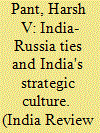

|
|
|
|
|
| Publication |
2013.
|
| Summary/Abstract |
India-Russia is a unique bilateral relationship in the Indian foreign policy matrix that refuses to become amarginal one, and that was onlymarginally affected by the unprecedented structural changes ushered in by the end of the ColdWar in the early 1990s. This article examines the main factors that drove India-Russia ties over the last six decades and, situating the discussion in the broader context of the debate on India's strategic culture, argues that the realist strand of thinking in Indian strategic discourse best explains the evolution and sustenance of strong bilateral ties between the two states.
|
|
|
|
|
|
|
|
|
|
|
|
|
|
|
|
| 18 |
ID:
139049
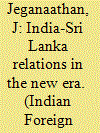

|
|
|
|
|
| Summary/Abstract |
There is no doubt that the Modi government is much more assertive and very articulate of its regional interests as compared to the previous government. It has clearly indicated that India would play a leadership role in South Asia, with less interference but more involvement in the development sectors in its neighbouring countries. It wants to make its footprint stronger in the economic development of neighbouring countries. This is not necessarily only to contain China’s aggressive inroads; rather, it is to expand both its shrinking markets as well as its cultural identity. The ‘SAARC Yatra’ by the new Foreign Secretary is an innovative strategy adopted by the MEA to strengthen India’s role in the neighbourhood. With its new leaderships, both India and Sri Lanka should take a fresh look at each other; and it is high time they take the bilateral relationship between the two countries to the next phase.
|
|
|
|
|
|
|
|
|
|
|
|
|
|
|
|
| 19 |
ID:
126110


|
|
|
|
|
| Publication |
2013.
|
| Summary/Abstract |
India-US strategic dialogue was initiated in 2009, and is organised annually in different capitals. The first round of dialogue took place against the backdrop of pessimism in the bilateral relationship. For about six months after the new Obama administration was formed, strategists in Delhi were suspicious about the durability of an India-US strategic partnership that had been painstakingly nurtured by President George W. Bush and Indian Prime Minister Manmohan Singh.
The India-US defence framework agreement signed in 2005 and the US-India civil nuclear cooperation agreement concluded in 2008 were the two most significant pillars of this 'strategic partnership'. These two agreements qualitatively transformed the paradigm of India-US relations prevalent during the Cold War. The defence framework agreement facilitated defence and security relations between the two countries, which had been strained during the Cold War. The strategy that essentially obstructed strategic cooperation between the US and India, namely the US non-proliferation policy, was done away with by the civil nuclear agreement.
|
|
|
|
|
|
|
|
|
|
|
|
|
|
|
|
| 20 |
ID:
080490
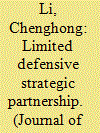

|
|
|
|
|
| Publication |
2007.
|
| Summary/Abstract |
The deepening rapprochement between China and Russia, those two formidable continental powers, constitutes one of the most noteworthy phenomena in post-Cold War world affairs. Through detailed investigation of this vital bilateral relationship over a variety of issue areas, we characterize the current Sino-Russian relations as a limited defensive strategic partnership, with strategicness constituting the core of the Sino-Russian relationship. More than that, we further argue that the Sino-Russian rapprochement is externally-driven rather than internally-driven. More specifically, realism's balance of power theory, or its variety balance of threat theory, provides a relatively convincing explanation regarding the increasingly strengthened Sino-Russian strategic partnership. In a roughly chronological way, this paper will demonstrate how America's increasing unilateralism in its foreign policy approaches was correlated with, and thus contributed to, the deepening rapprochement between China and Russia
|
|
|
|
|
|
|
|
|
|
|
|
|
|
|
|
|
|
|
|
|